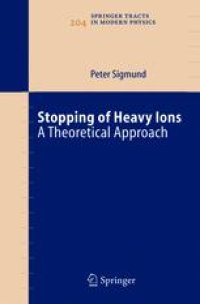
Ebook: Stopping of Heavy Ions: A Theoretical Approach
- Tags: Particle Acceleration and Detection Beam Physics, Atoms and Molecules in Strong Fields Plasma Physics, Surfaces and Interfaces Thin Films, Measurement Science Instrumentation, Characterization and Evaluation of Materials
- Series: Springer Tracts in Modern Physics 204
- Year: 2004
- Publisher: Springer-Verlag Berlin Heidelberg
- Edition: 1
- Language: English
- pdf
This book offers a concise presentation of theoretical concepts characterizing and quantifying the slowing down of swift heavy ions in matter. Although the penetration of charged particles through matter has been studied for almost a hundred years, the quantitative theory for swift penetrating ions heavier than helium has been developed mainly during the past decade and is still progressing rapidly. The book addresses scientists and engineers working at accelerators with an interest in materials analysis and modification, medical diagnostics and therapy, mass spectrometry and radiation damage, as well as atomic and nuclear physicists. Although not a textbook, this monograph represents a unique source of state-of-the-art information that is useful to a university teacher in any course involving the interaction of charged particles with matter.
This book offers a concise presentation of theoretical concepts characterizing and quantifying the slowing down of swift heavy ions in matter. Although the penetration of charged particles through matter has been studied for almost a hundred years, the quantitative theory for swift penetrating ions heavier than helium has been developed mainly during the past decade and is still progressing rapidly. The book addresses scientists and engineers working at accelerators with an interest in materials analysis and modification, medical diagnostics and therapy, mass spectrometry and radiation damage, as well as atomic and nuclear physicists. Although not a textbook, this monograph represents a unique source of state-of-the-art information that is useful to a university teacher in any course involving the interaction of charged particles with matter.
This book offers a concise presentation of theoretical concepts characterizing and quantifying the slowing down of swift heavy ions in matter. Although the penetration of charged particles through matter has been studied for almost a hundred years, the quantitative theory for swift penetrating ions heavier than helium has been developed mainly during the past decade and is still progressing rapidly. The book addresses scientists and engineers working at accelerators with an interest in materials analysis and modification, medical diagnostics and therapy, mass spectrometry and radiation damage, as well as atomic and nuclear physicists. Although not a textbook, this monograph represents a unique source of state-of-the-art information that is useful to a university teacher in any course involving the interaction of charged particles with matter.
Content:
Introduction....Pages 1-6
Definitions....Pages 7-14
Units, Fundamental Constants and Conversion Factors....Pages 15-18
General Considerations....Pages 19-28
Electronic Stopping of Point Charges....Pages 29-44
Electronic Stopping of Dressed Ions....Pages 45-58
Aggregation Effects....Pages 59-64
Low-Velocity Electronic Stopping....Pages 65-76
Survey of Current Theoretical Schemes....Pages 77-84
Nuclear Stopping....Pages 85-94
Related Processes....Pages 95-98
Statistics of Particle Penetration....Pages 99-108
Straggling....Pages 109-120
Multiple Scattering....Pages 121-124
Restricted Nuclear Stopping....Pages 125-134
Range and Range Straggling....Pages 135-144
Concluding Remarks....Pages 145-146
This book offers a concise presentation of theoretical concepts characterizing and quantifying the slowing down of swift heavy ions in matter. Although the penetration of charged particles through matter has been studied for almost a hundred years, the quantitative theory for swift penetrating ions heavier than helium has been developed mainly during the past decade and is still progressing rapidly. The book addresses scientists and engineers working at accelerators with an interest in materials analysis and modification, medical diagnostics and therapy, mass spectrometry and radiation damage, as well as atomic and nuclear physicists. Although not a textbook, this monograph represents a unique source of state-of-the-art information that is useful to a university teacher in any course involving the interaction of charged particles with matter.
Content:
Introduction....Pages 1-6
Definitions....Pages 7-14
Units, Fundamental Constants and Conversion Factors....Pages 15-18
General Considerations....Pages 19-28
Electronic Stopping of Point Charges....Pages 29-44
Electronic Stopping of Dressed Ions....Pages 45-58
Aggregation Effects....Pages 59-64
Low-Velocity Electronic Stopping....Pages 65-76
Survey of Current Theoretical Schemes....Pages 77-84
Nuclear Stopping....Pages 85-94
Related Processes....Pages 95-98
Statistics of Particle Penetration....Pages 99-108
Straggling....Pages 109-120
Multiple Scattering....Pages 121-124
Restricted Nuclear Stopping....Pages 125-134
Range and Range Straggling....Pages 135-144
Concluding Remarks....Pages 145-146
....